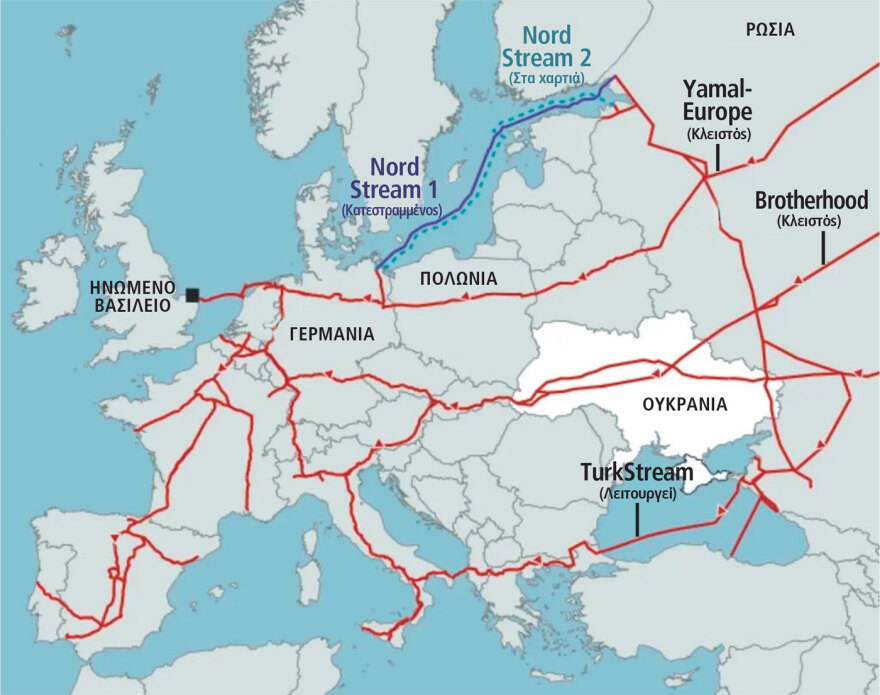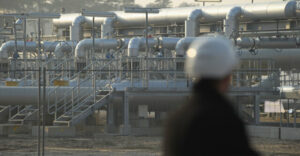In the course of the ongoing war in Ukraine, the Russian president, Vladimir Putin, seems to have realized that if he had a weapon in his hands with which to hit the Europeans, it wasn’t missiles. It is energy. So, after focusing his strikes on Ukraine’s energy facilities, transforming it from the largest exporter to the largest importer on the Old Continent, he is now shutting off the spigot of Gazprom’s former gas route to Europe after Kyiv refused to renew its agreement with Gazprom. Can this hurt the Europeans, and in what way?
This scenario, namely the interruption of Russian gas transit, is the main one that most European countries have been working on since the day the Russian invasion of Ukraine began. Some, like those in Southeast Europe, have locked up the flow of gas from the pipeline that brings regasified LNG from the Greek station at Revythoussa. Those in the Central and North, however, have to seek and quickly find alternatives, as the reserves they have held for this eventuality are being used up quickly, especially if a severe winter arises from here on out. And, without these gas supplies, it will be more difficult henceforth to replenish natural gas reserves.

No matter how ready countries are, however, the fact is that Gazprom’s closure of the pipeline will put pressure on the price of gas and hence the price of electricity. In support of this, already the uncertainty as to how Europe’s energy picture will evolve has translated into a rise in the price of gas on the TTF hub, after European benchmark futures (February delivery) exceeded the psychological threshold of €50/Mwh, recording a year high. Of course, this price is a far cry from the historical record of 25 August (312 EUR/Mwh) and the more general prices of that year, which were close to 200 EUR, but it is also well above the lowest level of last year, when, on 23 February, the gas price had fallen to 29.13 EUR.
With this market reaction, one could imagine that the interruption of the flow of natural gas from the Ukrainian pipeline, which has been supplying Europe with Russian “blue gold” for nearly half a century, would be a disaster for the Old Continent. Since the Soviet Union and then Russia, Moscow’s share of Europe’s energy supply has been high, reaching 35%. After Russia’s invasion of Ukraine, however, things changed for Gazprom. The Yamal-Europe pipeline through Belarus has been shut down. The Nord Stream pipeline connecting Germany to Russia was damaged by explosions in 2022, while the newer Nord Stream 2 connection was never approved by Berlin.
One could therefore recall with horror the last time Russian gas flows through Ukraine to Europe were cut off, in 2009. Back then, for about two weeks, more than 20 countries nearly … froze amid a very cold winter, until Russia and Ukraine signed the deal that expired today in practice as it was renewed by signing five-year contracts. But are the conditions the same? The answer is no. Today, Russian gas accounts for about 5% of the EU’s annual gas imports
With European gas consumption reaching 330 billion cubic meters per year, at the beginning of the five-year contract (2020), Russia had shipped 65 billion bcm to Europe and 15 in 2023, an amount that was further reduced last year.
Europe is anxious about prices, as – even if only a little – Russian gas via Ukraine stops at a time when annual demand for heating is rising as colder weather sets in, but there are countries and regions most affected. Transnistria is paralysed (heating and hot water cut off). In Moldova, where the temperature is approaching 0 degrees Celsius, the country has been placed in a 60-day emergency in the energy sector.
“Dress well. Gather all family members in one room, hang blankets – or thick curtains – on the windows, and use electric heaters.” That’s the advice energy companies are offering via Telegram. Industries have stopped operating, with the sole exception of food production plants. In the EU, the situation is different. The reason is that its countries have long since found or created alternative sources of liquefied natural gas (LNG) from Qatar and the US, as well as natural gas from Norway.
“The interruption of the flow through Ukraine on January 1 is the expected situation and the EU is prepared for it,” a European Commission spokesman commented in the past few days, noting that the Commission has been working with member states for more than a year to prepare for such a scenario.
The truth is that since 2022, the bloc has been diversifying its gas supplies, increasingly turning to LNG imports, mainly from the US. There are “various options” for arranging gas transit to Central and Eastern Europe, including through another pipeline route and LNG terminals, the German economy ministry explained last week.
Natural gas from Gazprom via Ukraine continues to be received by Austria and Slovakia from one of the two remaining routes supplying Russian gas to Europe. How the problem is being solved was explained by Slovakia’s largest energy provider, SPP, which said it has signed a “short-term, pilot gas supply contract” with Azerbaijan’s state oil and gas company Socar before the Ukraine transit agreement expires.
Russia still supplies gas to countries such as Serbia and Hungary through another pipeline, the TurkStream, which bypasses Ukraine. But this connection is not enough to fully compensate for the complete loss of the route from Ukraine.
What Europe is worried about is not so much whether it will run out of gas, but how it will fill its storage facilities with it, as they have had net withdrawals for 10 straight days, according to data from industry data provider Gas Infrastructure Europe.
Greece’s role
On the last Friday of 2024 (27 December) and pending the closure of the tap by Gazprom, for the first time, Ukraine received a cargo of natural gas via Greece and DESFA’s LNG terminal at Revithoussa. D. Trading was the first Ukrainian company to receive a cargo of 100 million cubic meters or 1 Twh of US gas.
Although only 10% of the cargo will go to Ukraine (the rest will be resold to Greek companies), the receipt of this cargo by Revithusa was rather of historical importance, as it also marked in practice the opening of the “vertical gas corridor” from our country to the soft underbelly of Russia. Not coincidentally, at the Lloyd’s Greek Shipping Awards, the Ship of the Year 2024 award was presented to Gastrade for the Alexandroupolis FSRU, the first Floating Storage and Gasification Unit for Liquefied Natural Gas in Greece, which constitutes a critical pillar for enhancing energy security and diversification of energy sources in Southeast and Central Europe. By enabling the transport of natural gas from Greece to the North in a safe, competitive, and efficient manner, the project promotes sustainable development and strengthens the energy autonomy of the region, decisively upgrading Greece’s role in the modern energy map of Europe, making it the energy gateway for more than nine countries in the framework of the Vertical Corridor initiative.
This was also the purpose for which the FSRU (ASFA) Alexandroupolis was built. Its purpose was and is to secure new quantities of natural gas for the supply of the Greek and the regional market of South-East Europe, contributing at the same time to the expansion of sources and supply routes of natural gas, to the promotion of competition for the benefit of the final consumer, to the security of supply of Greece and the Balkan countries, to the improvement of the reliability and flexibility of the National Natural Gas System as well as of the Regional and Trans-European Systems, but also to the strengthening of the regional and trans-European networks.
The Alexandroupolis FSRU has a gasification capacity of 5.5 billion cubic meters per year, a storage capacity of 153,500 cubic meters. The shareholders are – with a 20% share each – Elmina Kopelouzou, Gaslog, DEPA Emporia, Bulgartransgaz, and DESFA. Gastrade’s Alexandroupolis LNG terminal started commercial operation last October, contributing to energy security and the diversification of energy sources and supply routes in Southeast and Central Europe, decisively upgrading the role and importance of Greece in the modern energy map of Europe, making it the energy gateway for more than nine countries.
The terminal station of Alexandroupolis has been added to the one operating at Revithoussa, which until now also supplied the Balkan markets (which are becoming independent of Russian gas) via the Greek-Bulgarian IGB pipeline. Our country also receives quantities of Azerbaijani gas via the TAP pipeline, while Russian gas is received from Turkstream, which crosses the Black Sea to European Turkey, from there to Bulgaria, and then through the National Natural Gas Transmission System from the entry point in Sidirokastro to our country.
Greece imports about 5 billion cubic meters of natural gas a year, with 56.9% of total fossil fuel imports taken up by Russian gas – a quantity that is steadily decreasing. As the closure of the Ukrainian pipeline does not affect Greece, the only point of vulnerability for our country is the increases in gas prices that are passed on to the price of electricity. As 3 of the 5 billion cubic meters imported are directed to gas-fired power plants, our country is pinning its hopes on mitigating the impact on the participation of Renewable Energy Sources in the energy mix – as it has no storage facilities for the electricity they produce. According to data from the Greek Energy Exchange, natural gas (49.7%) accounted for the lion’s share of the country’s energy mix last Friday, with renewables mitigating the impact of the gas price rally, participating with 30.8%, followed in the mix by 12.58% of electricity imports and 4.07% of large hydropower.
With tankers
However, this does not spare Greece from the wholesale energy price explosions on the Greek energy exchange, which in one two-month period (November – December) exceeded 135%, soaring to 229.84 euros per Mwh, up from 91.92 euros on November 9. For last Friday, the wholesale price on the energy exchange remained stable at 123 euros per Mwh because renewables dominated the generation mix with 43%, followed by 40.3% from gas, 10.7% imports, 4.2% hydro, and 0.2% lignite. As Ukraine refuses to renew its five-year agreement with Gazprom to allow Russian gas to pass through its territory (citing unpaid fees from Moscow of more than €1 billion), it believes that Europe’s last tower of supply of Russian gas has fallen. The sanctions in place, with the closure of the pipeline, put Russia out of the game. But is that so?
The closure of the Russian gas pipeline with the closure of the Russian Federation puts the Russian Federation out of the game.
Russia, it has been revealed, has spent the last two years building up a shadow fleet of tankers to circumvent the sanctions and continue to make oil available on the world market. These are 100 tankers, including VLCCs (Very Large Crude Carriers) with a carrying capacity of more than 2 million barrels of crude oil each. To this fleet, Moscow, foreseeing the closure of the pipeline, has this year added at least three LNG carriers, which were acquired by Russian-linked operators, registered in Palau, and misrepresenting their positions so as not to appear to be loading from Russian units. These ships, “Everest Energy”, “New Energy” and “Pioneer”, have been spotted in international waters doing STS (Ship To Ship), i.e. ship-to-ship gas transfers, so that their cargoes thereby end up in the final markets… re-dipped in anything other than Russian gas.
Ask me anything
Explore related questions





